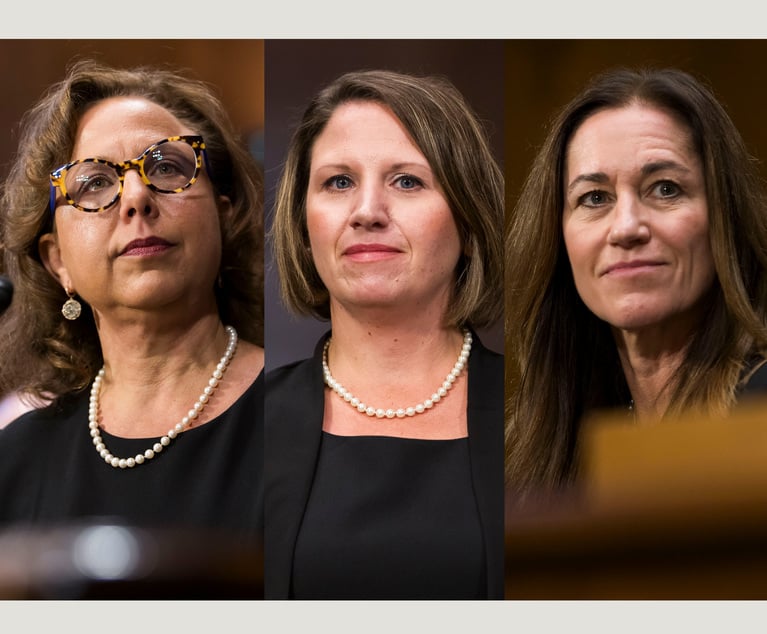Pa. Supreme Court Excludes Warrantless Search of Cellphone
On June 15, 2010, Michael Toll called 9-1-1 and reported he had been shot on a street corner in Philadelphia. A police officer responded and found Toll in his vehicle.
March 01, 2018 at 01:01 PM
7 minute read

On June 15, 2010, Michael Toll called 9-1-1 and reported he had been shot on a street corner in Philadelphia. A police officer responded and found Toll in his vehicle. He was still conscious, and like something out of an Agatha Christie novel, Toll told the officer that “Jeff” had reached through his window and shot him. He died two days later.
Toll's dying declaration set in motion an investigation that even the clever Christie would never have contemplated. The investigation led to a suspect, the search of a cellphone and intriguing things like “fruit of the poisonous tree,” “purged taint,” and the exclusionary rule. This case was a murder mystery wrapped in a law school exam.
The same day that Toll died, the police were called regarding a person with a gun. The police found four males—one being I. Dean Fulton. A gun was found, the men were arrested and incident to Fulton's arrest, his cellphone was taken into custody.
Ultimately, all of the cellphones were “opened, powered up and the menu [was] searched for a phone number corresponding to each phone.” A detective discovered Fulton's phone, a Samsung flip phone, had the number 267-206-7343; the same number was stored in Toll's phone under the name “Jeff.”
Subsequently a detective kept the cellphone on his desk and answered a phone call from a woman on Fulton's phone. The woman was a heroin user and called Fulton to buy drugs. The woman met with police and identified a photograph of Fulton whom she knew as “Jeff.”
Fulton sought to suppress the evidence taken from his phone as a result of the warrantless search of his cellphone. The suppression motion was denied and Fulton was convicted of third degree murder. The decision of the trial court was affirmed by the Superior Court and last month the Pennsylvania Supreme Court weighed in on this important Fourth Amendment issue.
The issue in Commonwealth v. Fulton, No. 3 EAP 2017, decided Feb. 21, 2018, is whether powering on a cellphone to gather evidence, without a warrant, violates the Fourth Amendment to the U.S. Constitution and Article I, Section 8 of the Pennsylvania Constitution.
Fulton argued that the trial court erred by denying his motion to suppress all information derived from the discovery of the 267-206-7343 cellphone number. Fulton relied on the U.S. Supreme Court decision in Riley v. California, and its companion case United States v. Wurie, 134 S. Ct. 2473 (2014) (Riley), and the Superior Court's decision in Commonwealth v. Stem, 96 A.3d 407 (Pa. Super. 2014) to assert that “the police may not open a … cellphone without first obtaining a search warrant for the cellphone.”
Not all warrantless searches are in violation of the Fourth Amendment or Article 1, Section 8 of the Pennsylvania Constitution. There are at least four clear exceptions to the warrant requirement. First there is the search incident to arrest exception; then the search in the presence of exigent circumstances; the automobile exception; and the “plain view” exception.
Prosecutors in Fulton suggested that the search by police was lawful because it was incident to arrest. The physical confiscation of the cellphone was incident to arrest and lawful without a warrant. How about turning it on, looking for the phone number and answering a call?
Judge Norman H. Stahl of the U.S. Court of Appeals for the First Circuit wrote in the lower court opinion in Wurie, “That [cellphone] information is, by and large, of a highly personal nature: photographs, videos, written and audio messages (text, email and voicemail), contacts, calendar appointments, web search and browsing history, purchases and financial and medical records.” He added, “It is the kind of information one would previously have stored in one's home.”
Prior to the decision in Riley, federal appellate courts were deeply split on the application of constitutional protections to modern technology. Riley's attorney said at the time, “At least six courts hold that the Fourth Amendment permits such searches, while at least three others hold that it does not.”
Chief Justice John Roberts, writing for a unanimous court in Riley, suggested, “One of the most notable distinguishing features of modern cellphones is their immense storage capacity … The storage capacity of cellphones has several interrelated consequences for privacy … The sum of an individual's private life can be reconstructed through a thousand photographs, labeled with dates, locations, and descriptions; the same cannot be said of a photograph or two of loved ones tucked into a wallet.”
The U.S. Supreme Court reasoned in Riley that the privacy concerns related to the search of a cellphone far exceed any such concerns related to the search of other physical items.
The Robert's court took a look at evolving technology and asked if the owner of a cellphone had a reasonable expectation of privacy with regard to the contents of the cellphone. The court determined that the owner of a cellphone does have a protected expectation of privacy and absent a warrant any search of the contents of the phone is unlawful.
The Pennsylvania Supreme Court in Fulton followed the reasoning in Riley. Justice Christine Donohue wrote, “The Riley/Wurie court held that in the absence of an applicable exception, any search of a cellphone requires a warrant.”
The exceptions to the search warrant requirement are premised on the impracticality of obtaining a warrant under circumstances such as hot pursuit, destruction of evidence or automobile searches.
In Fulton, no such exigency existed. The police had possession of the cellphone lawfully through the arrest of Fulton. The police could have easily obtained a warrant without the concern of evidence being destroyed or moved away.
The Pennsylvania Supreme Court was faced with the question of whether the warrantless search of the cellphone, and the identification of Fulton that arose as a result of answering the phone, should be excluded.
The matter proceeded on two levels. Initially, was the evidence subject to the exclusionary rule?
The landmark decision of Mapp v. Ohio, 367 U.S. 643 (1961) provided that if evidence was obtained due to police misconduct the evidence would be excluded from trial. The exclusionary rule was already in place on a federal level and Mapp made it applicable to the states. The decision gave some muscle to the court to deter police misconduct.
The Fulton court held that accessing any information from a cellphone without a warrant contravened the U.S. Supreme Court's decision in Riley, and was therefore excludable.
Evidence of any kind obtained by police through an unlawful search may not be used in any respect, including as evidence at trial against the subject of the search, Wong Sun v. United States, 371 U.S. 471, 485–86 (1963). As a result the identification of Fulton was fruit of the poisonous tree.
Next, prosecutors argued that the clear violation of Fulton's constitutional rights was harmless error.
Pursuant to Commonwealth v. Burno, 154 A.3d 764 (2017), harmless error exists if the commonwealth proves either: the error did not prejudice the defendant; or the erroneously admitted evidence was merely cumulative of other untainted evidence; or the properly admitted and uncontradicted evidence of guilt was overwhelming.
Justice Donohue wrote in Fulton, “The Superior Court erred by finding the warrantless searches of Fulton's flip phone [and the phone caller's interview and testimony] were permissible because they only minimally intruded on his privacy interests.”
Matthew T. Mangino is of counsel with Luxenberg, Garbett, Kelly & George. His book, “The Executioner's Toll,” 2010 was released by McFarland Publishing. You can reach him at www.mattmangino.com and follow him on Twitter @MatthewTMangino.
This content has been archived. It is available through our partners, LexisNexis® and Bloomberg Law.
To view this content, please continue to their sites.
Not a Lexis Subscriber?
Subscribe Now
Not a Bloomberg Law Subscriber?
Subscribe Now
NOT FOR REPRINT
© 2025 ALM Global, LLC, All Rights Reserved. Request academic re-use from www.copyright.com. All other uses, submit a request to [email protected]. For more information visit Asset & Logo Licensing.
You Might Like
View All
Pa. Federal District Courts Reach Full Complement Following Latest Confirmation

The Defense Bar Is Feeling the Strain: Busy Med Mal Trial Schedules Might Be Phila.'s 'New Normal'
7 minute read
Federal Judge Allows Elderly Woman's Consumer Protection Suit to Proceed Against Citizens Bank
5 minute read
Judge Leaves Statute of Limitations Question in Injury Crash Suit for a Jury
4 minute readTrending Stories
Who Got The Work
Michael G. Bongiorno, Andrew Scott Dulberg and Elizabeth E. Driscoll from Wilmer Cutler Pickering Hale and Dorr have stepped in to represent Symbotic Inc., an A.I.-enabled technology platform that focuses on increasing supply chain efficiency, and other defendants in a pending shareholder derivative lawsuit. The case, filed Oct. 2 in Massachusetts District Court by the Brown Law Firm on behalf of Stephen Austen, accuses certain officers and directors of misleading investors in regard to Symbotic's potential for margin growth by failing to disclose that the company was not equipped to timely deploy its systems or manage expenses through project delays. The case, assigned to U.S. District Judge Nathaniel M. Gorton, is 1:24-cv-12522, Austen v. Cohen et al.
Who Got The Work
Edmund Polubinski and Marie Killmond of Davis Polk & Wardwell have entered appearances for data platform software development company MongoDB and other defendants in a pending shareholder derivative lawsuit. The action, filed Oct. 7 in New York Southern District Court by the Brown Law Firm, accuses the company's directors and/or officers of falsely expressing confidence in the company’s restructuring of its sales incentive plan and downplaying the severity of decreases in its upfront commitments. The case is 1:24-cv-07594, Roy v. Ittycheria et al.
Who Got The Work
Amy O. Bruchs and Kurt F. Ellison of Michael Best & Friedrich have entered appearances for Epic Systems Corp. in a pending employment discrimination lawsuit. The suit was filed Sept. 7 in Wisconsin Western District Court by Levine Eisberner LLC and Siri & Glimstad on behalf of a project manager who claims that he was wrongfully terminated after applying for a religious exemption to the defendant's COVID-19 vaccine mandate. The case, assigned to U.S. Magistrate Judge Anita Marie Boor, is 3:24-cv-00630, Secker, Nathan v. Epic Systems Corporation.
Who Got The Work
David X. Sullivan, Thomas J. Finn and Gregory A. Hall from McCarter & English have entered appearances for Sunrun Installation Services in a pending civil rights lawsuit. The complaint was filed Sept. 4 in Connecticut District Court by attorney Robert M. Berke on behalf of former employee George Edward Steins, who was arrested and charged with employing an unregistered home improvement salesperson. The complaint alleges that had Sunrun informed the Connecticut Department of Consumer Protection that the plaintiff's employment had ended in 2017 and that he no longer held Sunrun's home improvement contractor license, he would not have been hit with charges, which were dismissed in May 2024. The case, assigned to U.S. District Judge Jeffrey A. Meyer, is 3:24-cv-01423, Steins v. Sunrun, Inc. et al.
Who Got The Work
Greenberg Traurig shareholder Joshua L. Raskin has entered an appearance for boohoo.com UK Ltd. in a pending patent infringement lawsuit. The suit, filed Sept. 3 in Texas Eastern District Court by Rozier Hardt McDonough on behalf of Alto Dynamics, asserts five patents related to an online shopping platform. The case, assigned to U.S. District Judge Rodney Gilstrap, is 2:24-cv-00719, Alto Dynamics, LLC v. boohoo.com UK Limited.
Featured Firms
Law Offices of Gary Martin Hays & Associates, P.C.
(470) 294-1674
Law Offices of Mark E. Salomone
(857) 444-6468
Smith & Hassler
(713) 739-1250





